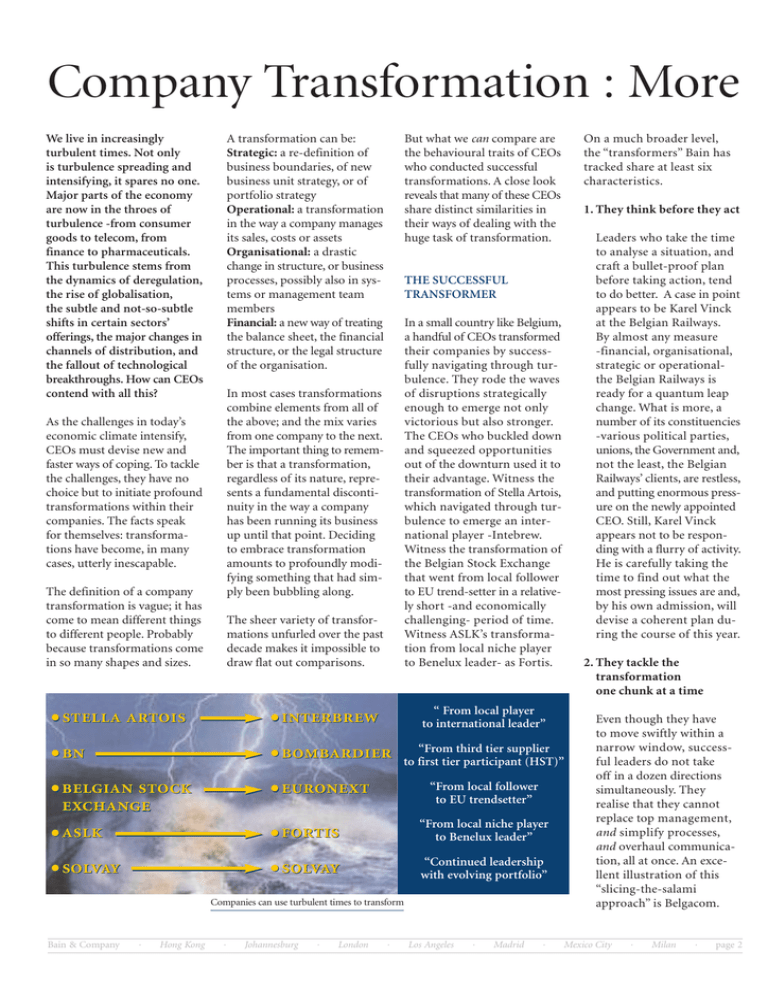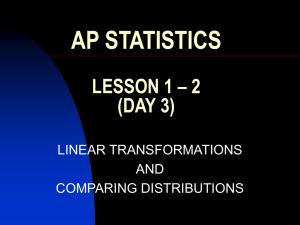A transformation can be: can On a much broader level,
advertisement

Company Transformation : More A transformation can be: Strategic: a re-definition of business boundaries, of new business unit strategy, or of portfolio strategy Operational: a transformation in the way a company manages its sales, costs or assets Organisational: a drastic change in structure, or business processes, possibly also in systems or management team members Financial: a new way of treating the balance sheet, the financial structure, or the legal structure of the organisation. We live in increasingly turbulent times. Not only is turbulence spreading and intensifying, it spares no one. Major parts of the economy are now in the throes of turbulence -from consumer goods to telecom, from finance to pharmaceuticals. This turbulence stems from the dynamics of deregulation, the rise of globalisation, the subtle and not-so-subtle shifts in certain sectors’ offerings, the major changes in channels of distribution, and the fallout of technological breakthroughs. How can CEOs contend with all this? But what we can compare are the behavioural traits of CEOs who conducted successful transformations. A close look reveals that many of these CEOs share distinct similarities in their ways of dealing with the huge task of transformation. The definition of a company transformation is vague; it has come to mean different things to different people. Probably because transformations come in so many shapes and sizes. • • • • • • • • • · Hong Kong · Johannesburg · London “From third tier supplier to first tier participant (HST)” “From local follower to EU trendsetter” “From local niche player to Benelux leader” “Continued leadership with evolving portfolio” · 2. They tackle the transformation one chunk at a time “ From local player to international leader” Companies can use turbulent times to transform Bain & Company Leaders who take the time to analyse a situation, and craft a bullet-proof plan before taking action, tend to do better. A case in point appears to be Karel Vinck at the Belgian Railways. By almost any measure -financial, organisational, strategic or operationalthe Belgian Railways is ready for a quantum leap change. What is more, a number of its constituencies -various political parties, unions, the Government and, not the least, the Belgian Railways’ clients, are restless, and putting enormous pressure on the newly appointed CEO. Still, Karel Vinck appears not to be responding with a flurry of activity. He is carefully taking the time to find out what the most pressing issues are and, by his own admission, will devise a coherent plan during the course of this year. In a small country like Belgium, a handful of CEOs transformed their companies by successfully navigating through turbulence. They rode the waves of disruptions strategically enough to emerge not only victorious but also stronger. The CEOs who buckled down and squeezed opportunities out of the downturn used it to their advantage. Witness the transformation of Stella Artois, which navigated through turbulence to emerge an international player -Intebrew. Witness the transformation of the Belgian Stock Exchange that went from local follower to EU trend-setter in a relatively short -and economically challenging- period of time. Witness ASLK’s transformation from local niche player to Benelux leader- as Fortis. The sheer variety of transformations unfurled over the past decade makes it impossible to draw flat out comparisons. • 1. They think before they act THE SUCCESSFUL TRANSFORMER In most cases transformations combine elements from all of the above; and the mix varies from one company to the next. The important thing to remember is that a transformation, regardless of its nature, represents a fundamental discontinuity in the way a company has been running its business up until that point. Deciding to embrace transformation amounts to profoundly modifying something that had simply been bubbling along. As the challenges in today’s economic climate intensify, CEOs must devise new and faster ways of coping. To tackle the challenges, they have no choice but to initiate profound transformations within their companies. The facts speak for themselves: transformations have become, in many cases, utterly inescapable. On a much broader level, the “transformers” Bain has tracked share at least six characteristics. Los Angeles · Madrid · Even though they have to move swiftly within a narrow window, successful leaders do not take off in a dozen directions simultaneously. They realise that they cannot replace top management, and simplify processes, and overhaul communication, all at once. An excellent illustration of this “slicing-the-salami approach” is Belgacom. Mexico City · Milan · page 2 a Science than an Art The late John Goossens admitted last September that “in 1995 we were involved with too many things at the same time, and things just went too fast.” Goossens was referring to Belgacom’s TURBO plan that sought to drastically change the corporate culture while replacing top management, simplifying processes, and overhauling communication, all at once. He soon elected to stagger his transformation efforts over time, as three distinct programs (Project Best, Project Horizon, Project Surf), each boasting a specific objective (i.e. cost reduction, image redefinition, etc.). Transformation process Strategic • Business boundaries unit • Business strategy • Corporate strategy 4. They selectively over-invest Successful CEOs understand that change costs money: in people, time or resources. They know that a transformation means a conscious decision to over-invest in leveraged areas. A CEO who identifies the most leveraged way to invest, and confidently hones in on it, tends to reap real results, fairly quickly. Take Euronext: the CEO elected to invest heavily in consultants to help pave the organisation’s ascension. Meanwhile, Bekaert chose to invest most heavily in recruiting super-premium talent for its top management. Successful transformation leaders realise that not everyone can specialise in everything, and that some managers are just not suited to certain tasks. As a result, they frequently change or rotate their senior managers. Even CEOs themselves can find themselves in the ejection seat. BusinessWeek claims that, in just the second half of 2002, “seven of Europe’s 35 largest companies replaced their CEOs” and that “European companies now appear more likely to fire the boss during hard times, than do US companies.” The ten most impressive industrial transformations we witnessed over the past decade occurred in companies where the CEO only kept his title for three years. · Munich • Sales • Costs • Assets Organisational Financial • Structure • Business processes • Systems • Management Team • Balance sheet • Financial structure • Tax/legal structure Transformations come in many shapes and sizes 3. They choose the right “horses for the courses” Bain & Company Operational 5. They communicate frequently and effectively As a company’s transformation unfolds, the CEO must communicate regularly, in a timely manner, to all parties involved. External audiences or internal ones, all are equally paramount. The CEO must be prepared to convey the appropriate message using the right tone and, no matter how trying things become, · New York · Paris · he or she must never let uncertainty within the ranks prevail. At the end of the day, running a large corporation is like governing a small country and leading the company’s transformation is also a political act. At Interbrew, Chairman and CEO spend up to 40 percent of their time communicating with all stakeholders. Both also understand that all their communications have to be carefully crafted and mutually reinforcing. 6. They must secure and maintain strong support from key stakeholders Successful transformation leaders realise that every company has a set of critical stakeholders that ultimately determine its success or demise. They are aware of the fact that, in any transformation, things can -and often do- go wrong. They will even admit that the very process of transformation is, almost by definition, mined from start to finish. When a CEO hits those trying moments he or she needs those key stakeholders to stand by him/her. Rome · San Francisco · A good example would be Bekaert, where CEO and senior management successfully maintained strong relations with the most critical stakeholders -the family shareholders. At the Belgian Post, one of management’s priorities is still gaining loyal support from the unions. Applying these six “rules of behaviour” does not necessarily guarantee a successful transformation. Nonetheless, our research supports the fact that they can significantly increase a leader’s chances of success. Principally because applying such common sense to a company transformation renders the process more controllable. As CEO’s gain more control, the “witchcraft” of company transformation becomes more transparent. Reality has demonstrated that successful transformations do not hinge on luck, a sprinkling of this and a dash of that. Successful transformations are in fact a science, more than an art. Luc Luyten, Partner Louis Amory, Partner Bain & Company Benelux São Paulo · Seoul page 3



